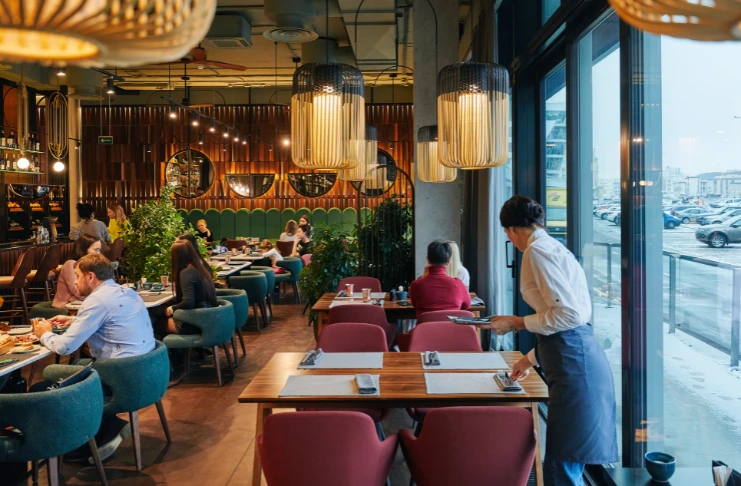If you’re searching the web for “How to run a successful restaurant”- know that that search is over. Running a successful restaurant is so much more than just good food– it requires strategic planning, operational excellence and adaptability. Delicious food is just one piece of the complex business puzzle. There is a lot more that goes into making a restaurant successful.
Running a restaurant is both an art and a science. Art comes from memorable experiences, and science is the system and processes that make those experiences consistently possible. The planning, operations, and adaptability are interconnected. When all three components work together harmoniously, you create a foundation that can support long-term success beyond simply serving good food. This guide shares proven strategies to help you succeed in today’s competitive market
Understanding the Restaurant Landscape
Before delving into how to run a successful restaurant and the various strategies, we first need to understand the restaurant landscape. According to a National Restaurant Association report, the Restaurant Industry is expected to reach $1.5 trillion in sales in 2025. The restaurant industry continues to evolve rapidly, and everybody is doing something different.
A 2025 report says 9 in 10 adults say they enjoy going to restaurants. Hence, understanding the market dynamics is the first step to learning how to make a restaurant successful.
Know Your Market Position
Before implementing any strategies, one of the most important tips for restaurant business is to understand your market position.
- Who are your primary competitors?
- What unique value do you offer?
- How do your prices compare to those of similar establishments?
Successful restaurant owners regularly conduct market analyses to identify opportunities and threats in their local market.
Essential Elements of a Successful Restaurant
1. Strategic Business Planning

Every successful restaurant concept starts with a comprehensive business plan. Your business plan must outline:
- Your concept and unique selling proposition
- Target market analysis
- Menu development strategy
- Staffing requirements
- Financial projections and funding needs
There is no rule that you cannot keep updating this plan. As your restaurant grows, you will keep needing new strategies to reach new heights. Keep revisiting and updating this outline to stay on track with your growth objectives.
2. Location and Atmosphere

Think from the perspective of a customer. You wouldn’t want to eat at a place that is too hard to reach, in some remote location, or eat somewhere that is next to a farm where all you can hear is the sheep bleating and the loud tractor sounds. Your restaurant’s location and ambience significantly impact its success rate:
- Choose a location with appropriate foot traffic for your concept
- Design your space to reflect your brand identity
- Create an atmosphere that enhances the dining experience
- Ensure accessibility and visibility
Remember that atmosphere extends beyond décor—lighting, music, temperature, and spacing all contribute to the dining room experience.
3. Menu Management & Food Quality

Your menu isn’t just the offerings you have at your establishment; it is a strategic marketing tool.
- Analyze your menu items’ profitability and popularity and trim your menus accordingly
- Streamline options to reduce inventory costs
- Highlight high-margin items through strategic placement
- Ensure consistent quality across all dishes
Manage your restaurant menu more effectively, with seasonal offerings, or create day schedules like breakfast, lunch and dinner and trim them. This allows not only customers to pick easily from what they would like, but also allows restaurant staff to function efficiently.
A focused menu can improve kitchen operations, leading to faster service and reduced labor costs. Industry research indicates that such strategies can enhance profit margins by 8-12%
4. Staff Training and Retention

Your team represents your restaurant and your brand to your customers.
- Develop comprehensive training programs
- Create clear career paths to improve retention
- Implement performance-based incentives
- Cultivate a positive workplace culture
In an industry with traditionally high turnover, restaurants with formal training programs report higher retention rates.
INDUSTRY INSIGHT
Implementing formal training programs in the restaurant industry has been shown to enhance employee retention rates.
| A study by Cornell University revealed that restaurants investing heavily in human resource practices, including comprehensive training, experienced annual employee turnover rates of 26%, compared to 45% in establishments with minimal HR investments. This indicates that robust training initiatives can lead to a 19% improvement in retention. A regional fast-food chain based in Tennessee exemplifies operational excellence in the restaurant industry. In 2001, it became the first restaurant company to receive the Malcolm Baldrige National Quality Award, recognizing its outstanding performance. They achieve this through rigorous employee training programs, including over 200 hours of training and regular pop quizzes, resulting in significantly low turnover rates. |
Operational Excellence in Restaurant Management
Before knowing how to run a successful restaurant, we must understand how to manage a restaurant business. Beyond great food, operational excellence ensures efficiency, cost control, and customer satisfaction.
By using customer expectations, optimizing workflows and leveraging data, restaurants turn challenges into opportunities for lasting success .
Financial Management

Knowing how to manage a restaurant business successfully begins with sound financial practices:
- Track key performance indicators (KPIs) daily
- Maintain food and beverage costs between 28-35%
- Monitor labor costs (aim for 25-35% of revenue)
- Implement inventory management systems to reduce waste
Successful restaurants typically maintain a prime cost (combined food and labor costs) below 60% of total revenue.
- Marketing and Customer Engagement
Building a loyal customer base requires strategic marketing:
- Develop a compelling online presence
- Implement a customer relationship management (CRM) system
- Create targeted promotions based on customer data
- Engage authentically on social media platforms
Restaurants investing in digital marketing report acquiring new customers at a 25% lower cost than traditional advertising.
- Technology Integration
A modern restaurant management software leverages technology:
- Point-of-sale (POS) systems that integrate with inventory
- Online reservation and ordering platforms
- Kitchen display systems to improve efficiency
- Data analytics tools for business intelligence
52% of restaurant operators plan to incorporate technology into back-office functions to enhance operational efficiencies.
Overcoming Common Challenges

You must know the common challenges that might come up and how you can overcome them:
- Managing Cash Flow
Cash flow challenges sink many restaurants, but they can be managed effectively. Implement these strategies to manage your cash flow:
- Negotiate favorable payment terms with vendors
- Consider a line of credit for seasonal fluctuations
- Monitor daily sales and expense trends
- Maintain a cash reserve of 2-3 months’ operating expenses
- Adapting to Industry Changes
The ability to pivot is essential for tips for restaurant business success:
- Stay informed about industry trends
- Regularly gather and implement customer feedback
- Test new concepts on a small scale before full implementation
- Network with other restaurant professionals
- Maintaining Consistency
Consistency builds customer trust and loyalty:
- Document standard operating procedures
- Conduct regular quality audits
- Implement checklists for opening and closing procedures
- Train staff to handle variations in business volume
Growth Strategies for Established Restaurants

Once you’ve mastered how to run a successful restaurant, consider these growth strategies:
1. Menu Expansion and Innovation
A well-curated menu keeps customers engaged and enhanced your brand identity. Expand your menu with:
- Seasonal menu updates to maintain customer interest
- Limited-time offerings to test new concepts
- Chef’s specials to utilize seasonal ingredients
- Signature items that define your brand
Continuously evolving your menu ensures freshness, creativity, and a loyal customer base.
2. Multiple Revenue Streams
Diversify beyond traditional dining:
- Catering services
- Retail products (sauces, spice blends, cookbooks)
- Cooking classes or demonstrations
- Meal kits or take-home options
BDO USA notes that during the pandemic, many restaurants that incorporated multiple revenue streams, such as takeout, delivery, and retail offerings, managed to stay afloat and even gained a long-term competitive advantage.
3. Scaling Your Concept
Consider expansion opportunities:
- Additional locations
- Ghost kitchens for delivery-only service
- Franchise opportunities
- Brand licensing
4. Measuring Success Beyond Profit
While profitability is essential, successful restaurants measure additional metrics:
- Customer satisfaction scores
- Employee retention rates
- Community engagement impact
- Sustainability improvements
Conclusion
Learning how to run a successful restaurant is an ongoing process of refinement and adaptation. The most successful restaurant owners combine: unwavering commitment to quality, data-driven decision making, exceptional customer experiences, strong team development, and financial discipline.
By implementing these strategies, you’ll be well-positioned to not just survive but thrive in the restaurant industry. What aspect of restaurant management would you like to improve first? The journey to restaurant success begins with identifying your greatest opportunity for growth.
Frequently Asked Questions
1. How can I make my restaurant more successful?
To make a restaurant successful, focus on quality food, excellent customer service, and make an engaging environment for customers. Optimize operations with technology and train staff well. Analyze sales data to refine menu pricing and reduce waste. Lastly, it is important to adapt to industry trends and customer preferences.
2. What are the three C’s in a restaurant?
The three C’s in a restaurant are Customer Service, Cleanliness, and Consistency. A restaurant that masters these three C’s will have strong customer retention, positive word-of-mouth marketing, and long-term success in a competitive industry.
3. What makes the most profit in a restaurant?
High-margin items like beverages (alcohol, coffee, soft drinks), appetizers, and desserts generate the most profit. Upselling strategies, such as combo deals or premium add-ons, further increase revenue. Cost control through efficient inventory management, portion control, and reduced food waste enhances profitability.
4. What is the restaurant key to success?
A well-executed menu, good quality food, exceptional service, and a strong brand identity build customer loyalty. Controlling costs by maintaining a healthy prime cost (food + labor) and optimizing operations and effective marketing. Additionally, staff training, operational efficiency, and adapting to market trends help sustain long-term success.
5. How do I run my restaurant?
Strong leadership, financial management, and customer focus are key points. Set clear goals, hire and train a dedicated team, and establish efficient operations. Monitor inventory, control food and labor costs, and maintain a clean, inviting space. Offer a unique menu and exceptional service. Invest in marketing, both digital and local, to attract customers. Use technology for reservations, ordering, and analytics to streamline operations.
6. How hard is running a restaurant?
Running a restaurant is challenging and time-intensive, requiring strong financial, operational, and people-management skills. Unexpected issues like high food costs, staffing shortages, and health regulations add complexity. The long hours, competition, and fluctuating customer demand make it demanding. With proper planning, strong leadership, and efficient systems, a restaurant can thrive and become a rewarding and lucrative business.
7. How profitable is running a restaurant?
Restaurant profit margins range from 3% to 10%, with quick-service earning more. Success depends on cost control, pricing, and diverse revenue streams like takeout and catering.
8. What is the most important thing to open a restaurant?
A solid business plan with location analysis, funding, and marketing is key. A unique concept, a skilled team, and efficiency ensure success.
9. What are tips for in a restaurant?
Some important tips for restaurant business are: prioritize customer experience, control costs, train staff well, keep the menu balanced, leverage digital marketing, ensure cleanliness, adapt to trends.
10. What are the four P’s of a restaurant?
The four P’s of a restaurant are Product, Price, Place, and Promotion. Balancing these factors is essential for a restaurant’s success.
11. How do I manage my own restaurant?
Manage a restaurant with strong leadership, cost control, and efficient operations. Train staff, ensure high quality food throughout, optimize pricing, and use technology. Stay engaged, adapt to trends, and build customer loyalty.
12. What not to do as a restaurant manager?
As a manager is to avoid making these mistakes: ignoring financial tracking, overcomplicating the menu, neglecting customer feedback, failure to train staff, underestimating marketing, overworking without delegation, ignoring hygiene and food safety first.
13. What is the daily routine of a restaurant manager?
A restaurant manager oversees restaurant management software inventory, staff, customer service, and food quality while tracking sales and ensuring compliance. They handle marketing, problem-solve, and keep operations running smoothly.
14. Is it hard to manage a restaurant?
Managing a restaurant is tough due to long hours, staffing issues, and cost control. It requires strong leadership, financial skills, and adaptability. Consistency in service and problem-solving are key. With proper planning and efficiency, success is achievable.





